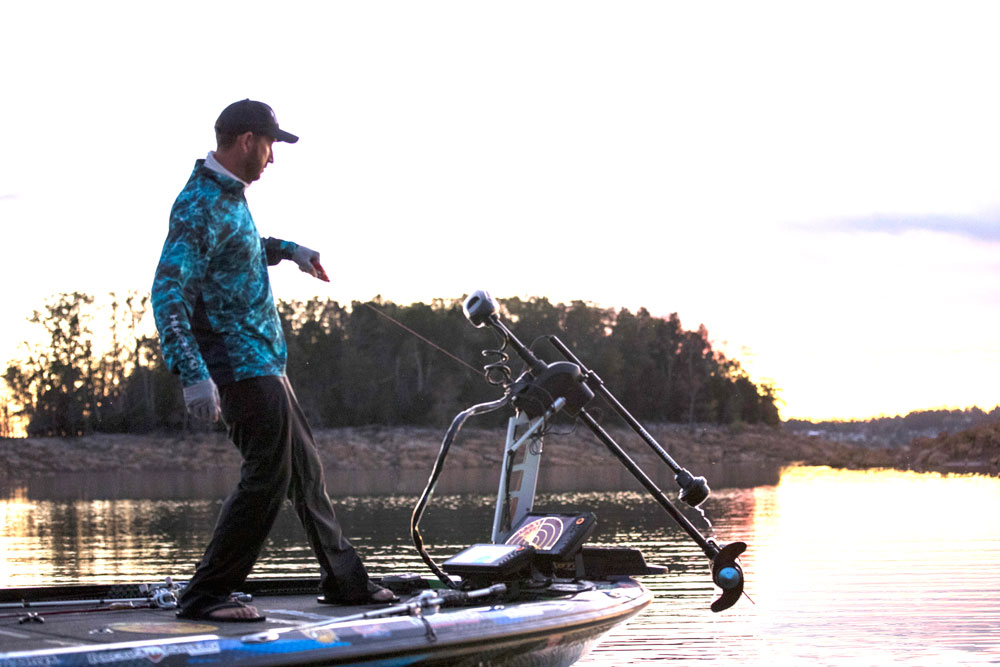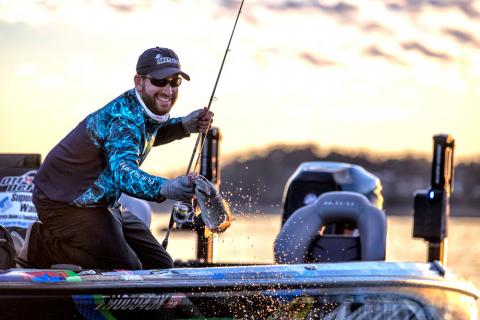provided by John E. Phillips
There’s no question about it, tackle does make a difference. New innovations, depth finders, lures, rods, reels and other equipment are allowing professional fisherman to catch as many or more fish than they have in the past. One of the most consistently successful pros is Ott DeFoe, winner of the 2019 Bassmaster Classic and ranked third in the world, according to BassFan.

Today, anglers have basically three choices in line: braid, fluorocarbon and monofilament. The line I use most of the time is fluorocarbon, braided is my second choice, and monofilament is my last choice. I choose fluorocarbon first because it has just a little bit of stretch. However, the main reason that I fish fluorocarbon is because it is the most invisible line on the market today, and I think it has a big effect on whether a bass will take a bait or not.
Monofilament has so much stretch, which can cause an angler not to get the hook deep in the bass’ mouth. Then an angler may lose more bass than he should. For this reason, I fish fluorocarbon 60-70 percent of the time when I’m bass fishing. Ninety percent of the time when I’m fishing spinning tackle, I’ll use braided line with a fluorocarbon leader, and 15-20 percent of the time when I’m using bait-casting tackle, I’ll use braided line either with or without a fluorocarbon leader.
The reason I like braided line for spinning tackle is because it doesn’t have any twist in the line, often called memory. (Memory is defined as the line remembering the coils that it had when it was spooled onto a spinning reel). So, when you cast, instead of coming straight off the spool, the coils in the line will slap the guides on the rod, reducing the length of the cast. But with braided line, you don’t have to deal with coil slap, and it doesn’t have any stretch. Also, today braided line is much smaller in diameter than the braided line your dad and or granddad once fished, which enables you to make longer casts too because there’s no stretch in the line. You can get a much harder hook set, even if the bass bites well away from the boat.
With spinning tackle, we fish quite a few small baits, and I can cast those baits so much further with braided line than I can with monofilament. Today’s 10-pound braided line is about the same diameter as 2-pound-test monofilament line, and my casts are so much further with braided line than they will be with a fluorocarbon line. When I’m fishing spinning tackle with braided line and using a fluorocarbon leader, I use the FG knot to make that connection between the fluorocarbon and the braided line. The FG knot is the strongest knot I’ve found for making this type of connection - whether I’m using a 10-pound braided line with a 6-pound-test fluorocarbon leader or 50-pound-test braided line to a 20-pound test fluorocarbon line. Although this knot is not necessarily the easiest knot to tie, I’ve tied it so much that I can do it fairly quickly now.
After I make that connection of the fluorocarbon to the braid, I like my fluorocarbon leader to be about 12 feet of 6-pound-test fluorocarbon tied to 10-pound-test braided line. But occasionally I’ll use 12-pound-test fluorocarbon line and shorten my leader by about 5 or 6 feet. If I’m using a fluorocarbon leader and 50- or 60-pound-test braided line on my bait-casting reel, I won’t have more than 5 or 6 feet of fluorocarbon leader line.
I use monofilament line when I’m fishing in the wintertime with a small crankbait on spinning tackle because when the weather’s very cold outside, and you have to worry about your line freezing-up or getting ice in the guides of your rod. The braided line on spinning tackle then will become a popsicle (freeze-up because it absorbs water), and you can’t cast the braided line at all. Too, fluorocarbon can become extremely brittle in really cold weather. So, during the winter is the only time I can think of that I fish with monofilament line.
In past years, common knowledge was, “You need to fish monofilament line when you’re fishing a crankbait because the monofilament gives in and allows the bass to suck the crankbait deeper into its mouth than other lines do.” The way I’ve solved this problem, so I don’t have to use monofilament line is I fish with a composite rod called a cranking stick from Bass Pro Shops that’s a softer rod (bends more) than my other rods do. This way I get some of the benefits of monofilament on the rod rather than having so much stretch in the line that I can’t get a solid hook set. Most of the fish that I’ve ever lost with monofilament has been because I wasn’t able to drive the hook deep enough in the fish’s mouth to have a solid hook set.
To learn more about Ott DeFoe, visit his Facebook page.






























